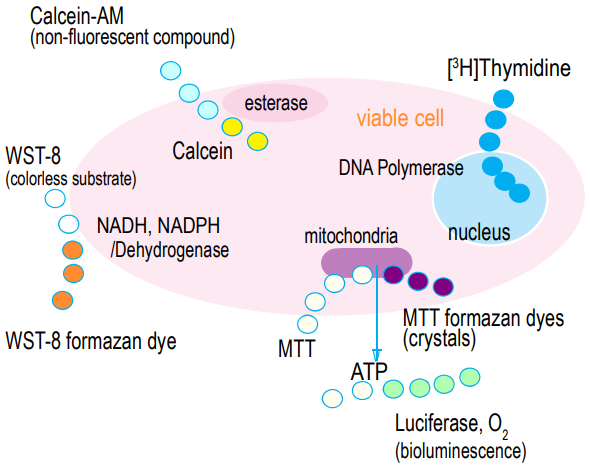Cytotoxicity is one of the most important indicators for in vitro biological evaluation. In vitro, physical and chemical agents may cause toxicity on cells via different mechanisms such as disrupting cell membranes, preventing protein synthesis, irreversible binding to receptors, inhibition of polydeoxynucleotide elongation and enzymatic reactions. In order to determine the cell death caused by these mechanisms, there is a need for cheap, reliable and reproducible short-term cytotoxicity and cell viability assays.
In vitro cytotoxicity and cell viability assays with cultured cells are widely used for toxicity testing and for drug screening. Currently, these assays are also used in oncological researches to evaluate both compound toxicity and tumor cell growth inhibition during drug development, as they are rapid, inexpensive and do not require the use of animals. Moreover, they are very useful for testing a large number of samples.
Choosing the appropriate method among these assays is important to obtain accurate and reliable results. When selecting the cytotoxicity and cell viability assays to be used in the study, different parameters must be considered, such as the availability of the laboratory where the study is to be performed, test compounds, detection mechanisms, specificity, and sensitivity.
Creative Bioarray offers a broad spectrum of cytotoxicity assays for toxicological and pharmacological studies. There are different classifications for these assays: 1) dye exclusion assays; 2) colorimetric assays; 3) fluorometric assays; and 4) luminometric assays.
- Dye exclusion: Trypan blue, eosin, Congo red, erythrosine B, neutral red assays.
- Colorimetric assays: XTT assay, MTT assay, MTS assay, WST-1 assay, WST-8 assay, LDH assay, NRU assay, SRB assay, and crystal violet assay.
- Fluorometric assays: Resazurin assay, Calcein-AM assay, and Alamar blue assay.
- Luminometric assays: ATP-based luminescent assay and real-time viability assay.

Creative Bioarray has developed several in vitro models, such as monolayer, co-culture, multilayer co-culture, xenograft models, and tissue slices to perform the cytotoxicity analysis on various chemicals. The cytotoxicity model system is useful in controlling cell adhesion, cell morphology, intercellular contact, cell-cell interaction, and has significant advantages over conventional in vitro systems.
Table 1. Common in vitro cytotoxicity models and their applications.
| In vitro models | Applications |
| Two-dimensional (2D) cell culture model |
|
| 2D co-culture model |
|
| Three-dimensional (3D) culture model |
|
| Tissue slice/grafting models |
|
| Microfluidic cell culture system |
|
Key Features
- Flexible custom testing solutions - single cell type, full cell panels or customer specific cell type
- Multiple endpoint analysis including cell viability, apoptosis, mitosis, stress and more
- Multiplex analysis
- Low concentration compound requirements
- Relevant reference compounds and vehicle controls are included on each plate
- Pre-validated human cells harvested and purified from single donor source
- Mitochondrial Toxicity Service
- Neurotoxicity Service
- Phototoxicity Testing Services
- Cardiotoxicity Testing Services
- Hepatotoxicity Testing Services
- Nephrotoxicity Testing Services
- Genetoxicity Testing Services